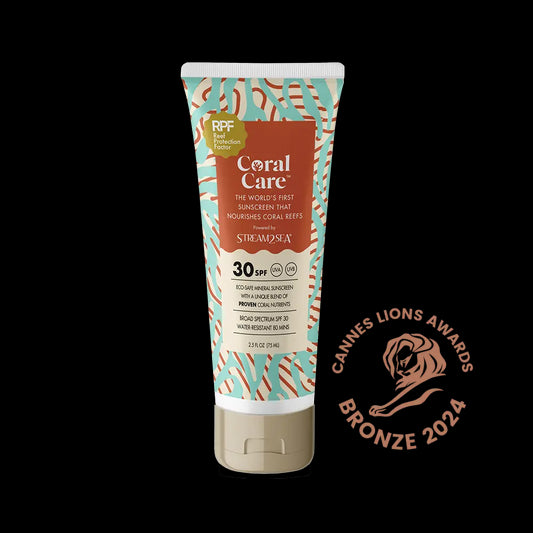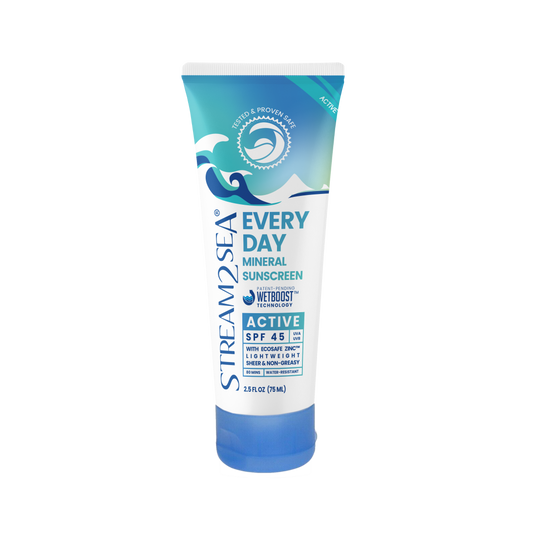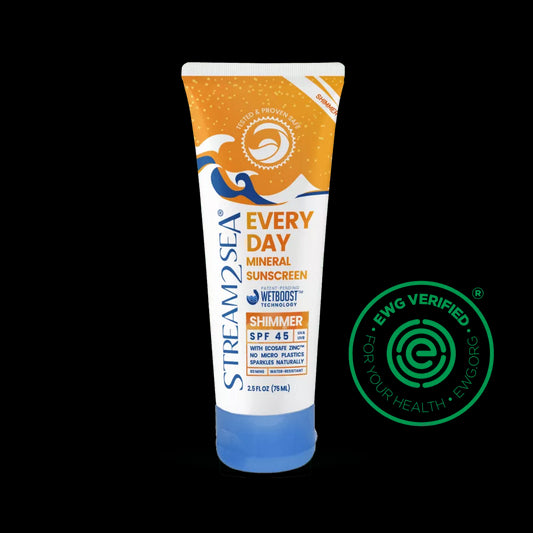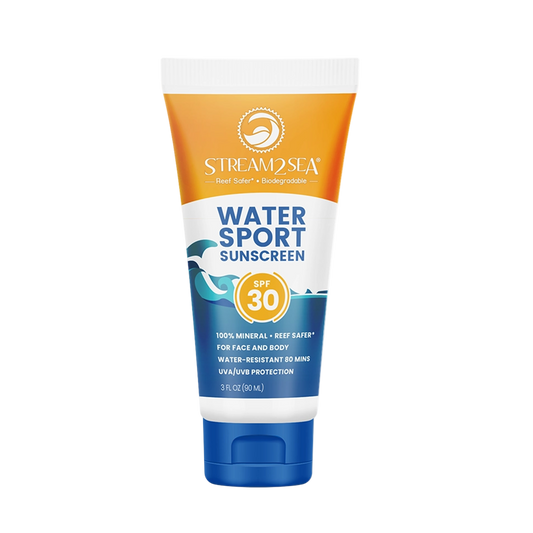Share
The truth about UV blockers, SPF ratings and the difference between UVA and UVB rays
The UV blockers in most sunscreens contain harmful chemical-based ingredients such as:
▪ Oxybenzone ▪ Avobenzone ▪ Octinoxate ▪ Cinnimates ▪ Homosalate ▪ Octocrylene These harmful chemicals each contain a different type of UV spectrum protection. When combined together, the formulator is attempting to cover as much of the spectrum from UVA and UVB rays as possible. Each harmful chemical only covers a spike within the range. It's sort of like trying to cover your head in the rain with just a bag over your hands instead of a broad-domed golf umbrella. When enough of these chemicals are combined together, formulators are attempting to build that protective shield, but it's not complete and has pockets of ineffective coverage.
Stream2Sea is the only mineral-based sunscreen that is tested and proven safer on freshwater fish, saltwater fish, C. Elegans AND Coral Larvae!
Biodegradable and safer for people and the environment, we are defining the meaning of ‘reef safer’ and use no ingredients known to harm creatures in a marine environment, like coral or nesting sea turtles.
Products using harmful chemical ingredients are often combined with parabens. Alone, benzophenones (oxybenzone and avobenzone) are endocrine disruptors, however when mixed together with parabens they create an even more powerful endocrine disruptor. This can cause health issues for both humans as well as the environment. Endocrine distruptors disturb things like hormones, development, weight, and metabolism.
Why do we "slather?"
The chemical-based products are recommended to be "slathered" on because they must absorb into the skin to protect from UV rays. This is why most containers state to apply 15 minutes before sun exposure, to allow the product to activate in the body. These chemicals can remain in the body, building up over time. The excess is passed on to our water ways where it can impact the environment or may be re-routed back to our drinking waters. Our mineral sunscreen works by reflecting the UV rays away from the body instead of absorbing into your skin!
The Truth on SPF Ratings
 Many people believe that the higher the SPF, the more protection they're getting from UV rays. This belief compels some to buy SPFs of 70 and 100, particularly for their children.
Many people believe that the higher the SPF, the more protection they're getting from UV rays. This belief compels some to buy SPFs of 70 and 100, particularly for their children.
SPF - Sun Protection Factor is not actually a measurement of protection like a thickness of a barrier, it's a measurement of time the wearer will be protected from a percentage of sun exposure.
To be safer, 80 minutes is the recommended exposure time before re-applying. Most people assume that the higher the SPF, the greater the protection, or the longer they can go between applications. For instance a common misconception is that an SPF 50 would give almost double the protection of an SPF 30, but in reality: An SPF of 30 protects from 97.2% of UV rays for 80 minutes An SPF of 50 protects from 97.7% of UV rays for the same 80 minutes. Anything beyond a 50 only increases the percentage in tenths of a percent, but requires far more UV inhibitor ingredients to achieve this level. Not only is the number questionable, but in the case of chemical-based UV inhibitors, the body is absorbing double to triple the amount of harmful chemicals without truly providing more protection. SPF ratings are sort of like the battery on your mobile device. When you buy the phone the quick-start guide in the box may say, "12 hour battery life with regular use!" Whose regular use? The person who uses their device mostly as a phone, basic texting, as a camera for occasional pics and only uses the internet as a necessity with a limited data plan? Or the person who streams music, movies, is on social media constantly, texts non-stop and is editing and uploading videos filmed with the phone to their blog or YouTube channel on an unlimited plan? Two very different uses of the battery life. Do you keep the brightness of your screen at max on your device? That burns up the battery quickly! Think of this as your skin's ability to absorb UV rays before burning. The higher the sun is in the sky (between the hours of 10am and 4pm), on a bright, clear day on a sandy beach, pale concrete, snow, on the water or at high elevations - that's like turning your device's display setting to max brightness and disabling the auto-time-out or auto-off. You have a very limited period of time before your device is going to run out of battery-power. Same is true for how quickly your skin will burn under those sunlight exposure conditions. Other factors like swimming, sweating, playing contact sports and fairness of skin tone will all contribute to the importance of paying attention to how often your reapply your sunscreen.
What is the difference between UVA and UVB and which does what??
UVA
- Penetrates deeper
- Causes tanning
- Causes advanced signs of aging (photoaging)
- Causes the release of free-radicals
- Causes DNA damage which relates to melanoma cancer
- Contributes to/stimulates squamous and basal skin cancers
- Development of squamous and basal skin cancers from skin damage
UVB
- Causes reddening of skin
- Causes painful burning resulting in blistering, peeling, freckling and possible scarring
- Contributes to beginning of tanning
- Development of squamous and basal skin cancers from skin damage
People with darker complexions should not assume they can't or won't burn. While someone with more natural melanin in their skin (dark natural skin tone) is more resistant to surface burns like those caused by UVB rays, it does happen, but more often these individuals are subject to the damage from UVA rays. UVA rays account for 95% of UV exposure on Earth and can penetrate glass. Yes, Vitamin D3 is produced from the exposure to UVB rays, but this occurs with as little as 8 to 15 minutes during morning or late afternoon sun exposure. If you're spending more time than that outdoors, its highly recommended to use light weight clothing and a hat for coverage along with a non-nano, mineral-based sunscreen on exposed areas.
Broad spectrum, Non-Nano Mineral-based Sunscreen
 Mineral-based sunscreens work by sitting on top of the skin and acting as a shield, like the broad-domed golf umbrella, reflecting UV rays. Stream2Sea's formula combines 100% non-nano titanium dioxide, proven to be safer for corals and reef life, with a powerful botanical antigen mix of aloe, olive, tulsi, green tea and wakame seaweed. This formulation is tested and proven broad spectrum protection for both UVA and UVB rays. Read more about our testing and the results.
Mineral-based sunscreens work by sitting on top of the skin and acting as a shield, like the broad-domed golf umbrella, reflecting UV rays. Stream2Sea's formula combines 100% non-nano titanium dioxide, proven to be safer for corals and reef life, with a powerful botanical antigen mix of aloe, olive, tulsi, green tea and wakame seaweed. This formulation is tested and proven broad spectrum protection for both UVA and UVB rays. Read more about our testing and the results.
![[S2S] After-sun Care](http://stream2sea.com/cdn/shop/collections/SPF30_and_Sun_Sting_Gel.jpg?v=1764789810&width=1500)





